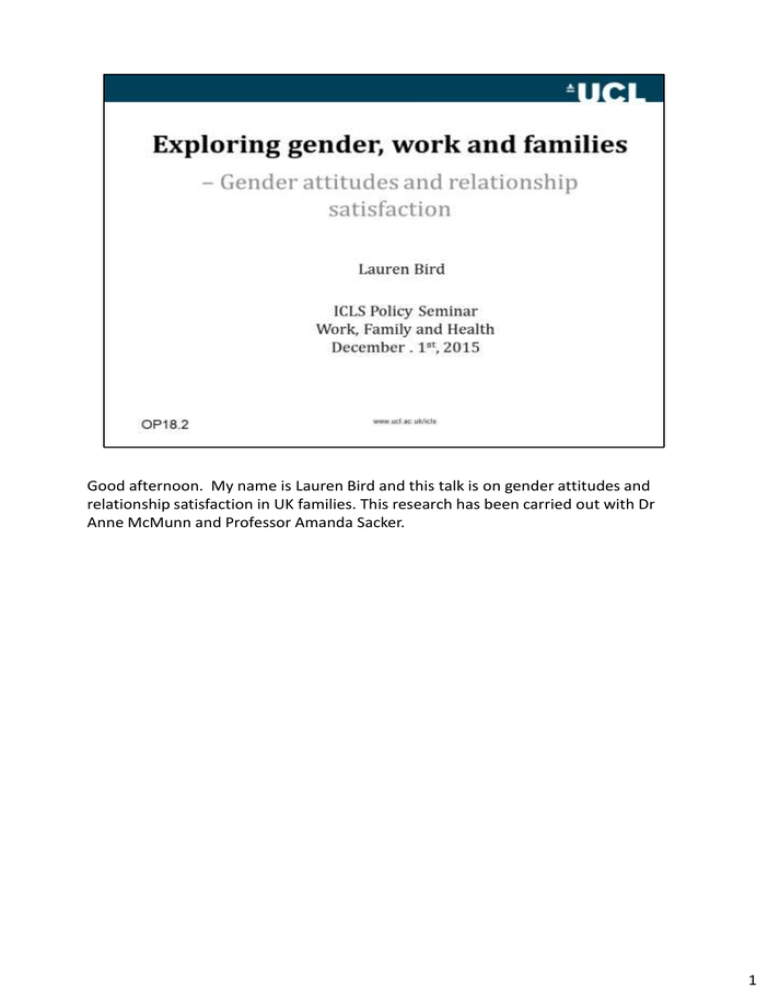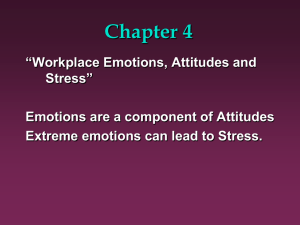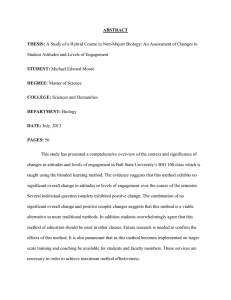
Good afternoon. My name is Lauren Bird and this talk is on gender attitudes and
relationship satisfaction in UK families. This research has been carried out with Dr
Anne McMunn and Professor Amanda Sacker.
1
OP18.2
www.ucl.ac.uk/icls
To begin with I want to identify what I mean by gender attitudes and behaviours. We
define gender separately from sex. When we are thinking of sex we are thinking of
biological differences between men and women. When we talk about gender we are
talking about social cultural differences. And social cultural differences can vary
across countries or regions and can also vary across time and even within an
individual across their life course.
Types of gender attitudes can include attitudes to employment - not only whether or
not you are in employment but also types of employment can be shaped by various
gender attitudes. Common gender attitudes include distinctions between men’s and
women’s roles within the home domestic sphere, an example would be a belief that
childcare is best performed by women or paid labour is more suited to men.
When we talk about gender behaviours we are talking about what people actually
do.
Gender attitudes do not necessarily agree with gender behaviours. Some individuals
may believe that paid work should be divided equally between men and women but
in reality consequences of having a family, such as expensive childcare, can result in
gender behaviours contrary to gender attitudes. An individual may wish to work but
you cannot afford to, while another individual may wish to spend more time with
their children but cannot afford to reduce their work hours.
2
The big questions are:
- What happens when there are disagreements within a relationship or within a
couple regarding these gender attitudes and gender behaviours?
- What happens when there are differences between an individual’s gender attitudes
and their workplace environment or culture, their family or their social
environment?
- What happens when these attitudes and behaviours do not match up?
- Can conflict between an individual’s attitudes about work and family life and
actual behaviours in work and family life, actually affect their outcomes?
The outcome of focus today is relationship satisfaction.
3
www.ucl.ac.uk/icls
The study that I use is the Millennium Cohort Study and as was mentioned
previously this is the most recent of the large British birth cohorts studies. This study
follows children across the United Kingdom born between 2000 and 2002.
The study follows a target child and that target child’s parents or carers were
interviewed. We had a rich variety of data from most of the mothers as well as many
of the fathers on not only the child’s life and the child’s environment but on the
parents’ behaviours and attitudes too.
We have selected families where there was a response from two parents and we
focus only on two parent families because of that interest in conflicts or
disagreements, however, they are not necessarily married and they are not
necessarily natural parents but they are two parents or social parents who are living
together in the same household.
We have around 12,000 families in this sample and all of the data that I am using
was collected when the child was about nine months old so we can particularly talk
about family life when there is at least one young child in the household.
4
www.ucl.ac.uk/icls
These are the gender attitude questions that got asked in the survey, they are all
focused on maternal employment. They are: “whether a child is likely to suffer if his
or her mother works before he or she starts school;” “all in all family life suffers
when a woman has a full-time job;” and “a mother and her family would be happier
if she goes out to work”.
5
The outcome is relationship satisfaction. There are seven questions in the
Millennium Cohort Study on relationship satisfaction, they are from the Golombok
Rust Inventory of Marital State. “My partner is usually sensitive to and aware of my
needs.” “My partner doesn’t seem to listen to me.” “I sometimes feel lonely even
when I am with my partner.” “Our relationship is full of joy and excitement.” “I wish
there was more warmth and affection between us.” “I suspect we may be on the
brink of separation.” “We can always make up quickly after an argument.”
All of these questions were combined to make a scale so that you have a total score
of relationship satisfaction. Out of interest when you look at these variables
individually, the most common thing for both men and women to feel is missing in
their relationship was question five. Approximately 25% of men and 20% of women
agreed or strongly agreed that they wish there was more warmth and affection in
their relationship. The next most common one for both men and women was
number three, I sometimes feel lonely. Remember that these are families with a
young child in their households. Generally many are quite satisfied but a lot are
feeling that they wish there was more warmth and affection and sometimes feel
lonely with their partner.
6
So the two questions I want to begin with are do couples have greater relationship
satisfaction when they agree or they share the same gender attitudes, and can we say
whether more egalitarian couples have better relationship satisfaction than less
egalitarian couples.
7
This graph shows our first set of results. This graph plots mothers’ relationship
satisfaction; on the left axis we have a prediction for the satisfaction score where the
higher the score the greater their satisfaction in their relationship. This graph plots
relationship satisfaction in relation to the results of a regression analyses but is
focused on our variables of interest – the lines represent interacting mothers’ gender
attitudes with their partners’ gender attitudes. The mothers’ attitudes are along the
horizontal axis and the different coloured lines represent the father’s attitudes.
Therefore, the left side of the graph has the most egalitarian mothers and to the
right are the least egalitarian mothers. The green line represents the most egalitarian
fathers and the red the least.
I’d like to draw your attention to the top left corner of the graph where you can see
that women who have more egalitarian attitudes and are partnered with a partner
who also has egalitarian attitudes (green line) have the highest relationship
satisfaction.
This graph also highlights the importance of agreement between couples because
the second highest satisfaction is in the least egalitarian mothers partnered with the
least egalitarian partners (top right corner & red line). So we really see the effect of
the conflict that as you move from more to less egalitarian attitudes if you disagree
with your partner your relationship satisfaction goes down quite strongly.
8
For men we have the very same picture. The most egalitarian fathers partnered with
most egalitarian wives have the highest relationship satisfaction, and least
egalitarian fathers with most egalitarian wives have the lowest. So there is a strong
influence of the conflict between couples and overall the most egalitarian ones have
higher satisfaction.
9
www.ucl.ac.uk/icls
In answer to the first question: do couples have greater relationship
satisfaction when they share the same gender attitudes - the answer is yes.
Both concordant egalitarian and concordant non-egalitarian partnerships had
higher relationship satisfaction than the couples that had disagreeing gender
attitudes.
Our second question: Can we say whether more egalitarian couples have
better relationship satisfaction than the less egalitarian couples? Overall we
can say that as well.
It’s also interesting to note that where the couples were discordant an
individuals relationship satisfaction was higher if they were the egalitarian
partner in the relationship compared to being the one with less egalitarian
gender attitudes in a couple.
10
The next question focused on conflict between the gender attitudes of an individual
(both the mother and the father separately) and the actual maternal employment in
that household.
As I mentioned at the beginning, you may have personal attitudes towards the
gender division of labour that you would prefer but that doesn’t necessarily translate
into the actual employment behaviours in the household because of the types of
economic and childcare requirements in the household. Therefore an individual can
have a conflict within their own attitudes and behaviours.
11
So what I am looking at in this graph is the gender attitudes for
mothers and their relationship satisfaction by the hours of work. And
you can see when you don’t work any hours, this is zero hours on the
left, doesn’t actually matter what your gender attitudes are but as a
mother with low egalitarian attitudes increases her work relationship
quality declines quite significantly. You will also notice that the most
egalitarian mothers have a slight decline in their relationship
satisfaction the more hours they work. But this graph is from a model
which actually adjusts for income, education and occupational social
class. So if you don’t adjust for those variables women actually in the
most egalitarian groups their satisfaction goes up. It’s just that that
seems to be an effect of their income and their education.
12
Fathers with the most egalitarian attitudes relationship satisfaction improved as their
wives worked more hours even again accounting for all education, economic and
social class variables (green line). But the fathers with least egalitarian attitudes had,
like the mothers, a very stark decline in their relationship satisfaction (red dash line).
13
This research shows that it is important to consider the relationship between what
you believe and what you are actually do for maternal employment. To return to the
question “does relationship satisfaction decline when there is a conflict between a
person’s gender attitudes and the actual maternal employment in the household”
the answer is yes, people with the least egalitarian attitudes experience the greatest
declines in relationship satisfaction as mothers’ hours are increasingly spent in paid
work.
14
OP18.2
www.ucl.ac.uk/icls
Another important area to acknowledge is the division of domestic
labour. We’ve focused on gender attitudes to employment. We did not
have a comparable variable on gender attitudes to domestic labour,
however, we did have data on domestic labour behaviours in the
household. The mothers in the Millennium Cohort Study were asked a
series of questions on both housework and childcare. Questions
included: who does the most cooking, cleaning, laundry, as well who
has most responsibility for feeding the baby, changing the baby’s
diapers and a few more similar questions.
These questions were combined into a single variable of five
categories moving from the most egalitarian group where couple split
most chores more or less equally and some fathers were also reported
to do more than their partners on certain household tasks to the least
egalitarian group where mother’s reported that they were responsible
for every task. Considering this division of domestic labour in our
models of relationship satisfaction, we found that both mothers and
fathers benefited from being in a more egalitarian household in terms
of domestic labour.
It’s not too surprising that women whose partners contribute to
domestic labour (both chores and childcare) had greater relationship
satisfaction as that has been observed in the research literature, but
15
we additionally reinforced that more egalitarian divisions of labour was
also positive for men.
15
To conclude, I want to give you some policy implications - you may think of some
other ones relevant to your areas of expertise:
Firstly, in terms of improving satisfaction for individuals and couples,
It’s important to promote and support open communication about expectations and
gender attitudes between couples because the conflict between individuals’
attitudes in a relationship can have considerable connections to areas of concern
such as relationship satisfaction. As was mentioned earlier, when a child is born and
when a child comes into the household there’s often a reset in terms of the gender
division of labour. If this reset occurs when a child is born and a couple have not
actually discussed who will do what before the birth there may be negative
consequences.
Supporting understanding for the relationship between gender attitudes and work
for individuals – ensuring that people are aware that if gender attitudes to work and
actual work behaviour are in conflict may also be associated with poorer satisfaction.
Promoting or supporting shared engagement and responsibilities in the household
division of labour would be beneficial for both men and women.
16
Policy Implications for the workplace?
What can we do to support equality in the workplace?
Promote shared parental leave. Shared parental leave recently got a boost in April
2015 whereby men have a far greater access to shared parental leave. But having the
policies in place for shared parental leave does not necessarily mean that men and
women equally take up shared parental leave. So there is a need for a commitment
to actually make that the workplace norm.
We know from the example of other countries that have had shared parental leave
programmes (or similar) for longer periods of time, that the opportunity to take up
leave by fathers is often not used do to cultural or workplace stereotypes, fears
about job security etc. Therefore there is considerable need to really promote
equality in parental leave to help make it the new norm, otherwise men may not
take it up because of social pressures, whether or not that pressure is actually in the
workplace.
Be alert to any gendered expectations or stereotypes in the workplace, making sure
that when new staff start both men and women are made aware of policies and
benefits such as opportunities for flexible leave arrangements.
Promote equal access to those support systems. Make sure that everyone is aware
of flexible time, childcare availability, career breaks, unpaid leave, all these types of
17
policies that we’ve discussed throughout the day. Make sure that those policies are
promoted equally to men and women. Opportunities for equality in the workplace
will benefit households as well, because couples can more equally share domestic
obligations if they each have access to workplace benefits.
17
Notes:
ICLS hosted a policy seminar on Work, Family and Health at UCL in December 2015. The
seminar was chaired by Richard Bartholomew, (former), Chief Research Officer, Children,
Young People and Families Directorate, Department for Education and the presentations
coordinated by Dr Anne McMunn, ICLS Co-investigator and UCL Graduate Tutor .
Transcripts from this event, including this paper, have been made available via the ICLS
Occasional Paper Series. This series allows for those who were not able to attend to read an
account of the presentation. Other papers in the series include:
OP18.1 Work to Family conflict and Family to Work conflict- who is more at risk? Tarani
Chandola, University of Manchester and ICLS
OP18.3 Balancing work and family over the life course and women’s health in later life. Juliet
Stone CPC, University of Southampton
OP18.4 Work-family life courses and stress and inflammation in mid-life. Rebecca Lacey,
UCL
Speaker: Lauren Bird is a PhD student in the UCL Department of Epidemiology & Public
Health. She is currently completing her PhD as part of a European Research Council funded
project under Dr Anne McMunn. Lauren’s research focuses on the dynamics of gender
attitudes and the division of labour in UK families.
ICLS Occasional Paper 18.2, Jan 2016
© 2016 Bird, L. All rights reserved
www.ucl.ac.uk/icls/publications/op
18








